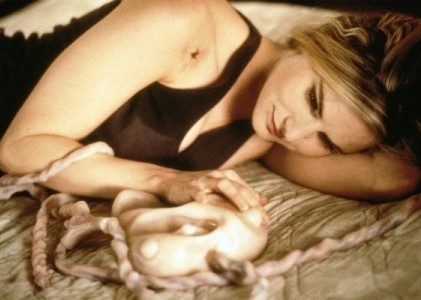They Came From Within
Not since Busby Berkelely’s undulating tunnels of bare legs and Judy Chicago’s labia dinner plates has there been an artist as yonic-centric as David Cronenberg. But what exactly does that term mean? To clarify that yonic is the opposite of phallic is a start, but does it refer to the inside or the outside? The vulva, the slit, the bleeding wound, or (according to Freud’s castration complex theories) the lack? Or do we mean what’s inside, the mysterious landscape that is the real counterpart to the phallic symbol? If we mean the inside, and I do, then how do we see what’s there? With blindsight? Through feel, through technology, and through gynecologists? It makes sense, then, that this is Cronenberg territory.
Phallic symbolism is easy to spot; look at any skyscraper, at any movie with a knifing or a shoot-out. But it’s taken Cronenberg’s whole career so far to cover the full spectrum of the yonic realm and its emotional resonances. Will it be possible to see plenteous yonic symbolism everywhere in art, too, now that it has been named? That’s doubtful in a phallocentric society that is obsessed with the visible—we have no female equivalent of "thinking with your dick," neither with the term nor the action. Also, the yonic is complex and hidden to the naked eye, and so takes a long commitment to explore fully. It is a noble goal, in art or in life, to focus one’s lifetime getting to know another human body. (Including mental aspects of a woman’s sexuality, as Cronenberg has done in the clinical explorations in his latest film, A Dangerous Method, and in most of his films since the mind-fuck movies Crash and eXistenZ.)

David Cronenberg on the set of A Dangerous Method
A Dangerous Method is about Freud, but Cronenberg’s entire career offers an extension of Freud’s body-based thoughts, continuing where Freud most obviously fell off the rails, with his theories on penis envy. The erroneous pre-history of women according to Freud: "The castration complex of girls is also started by the sight of the genitals of the other sex. They at once notice the difference and, it must be admitted, its significance too. They feel seriously wronged, often declare that they ‘want to have something like it too,’ and fall victim to ‘envy for the penis,’ which will leave ineradicable traces on their development and the formation of their character and which will not be surmounted in even the most favorable cases without a severe expenditure of psychical energy."
While Freud saw a woman’s sex as the absence of a penis, as a reminder of castration, Cronenberg saw the complexities of what was there, what was unseen or hidden, and has illustrated this in at least seven—and perhaps more—of his films. Described by Scorsese as looking like a Beverly Hills gynecologist, Cronenberg plays this role cinematically across his oeuvre, not shying from the creepy power-dynamic drawbacks. "I remember when I was in school that gynecologists had a lot of trouble with the ladies," he said when Dead Ringers was released. "It was obvious to me that gynecology meant a very well established relationship with the opposite sex, with the doctor having the upper hand....They know more about the woman’s body than she does. On a technical level. But it’s possible to develop an aesthetic point of view about this, which is what I’m trying to explore."
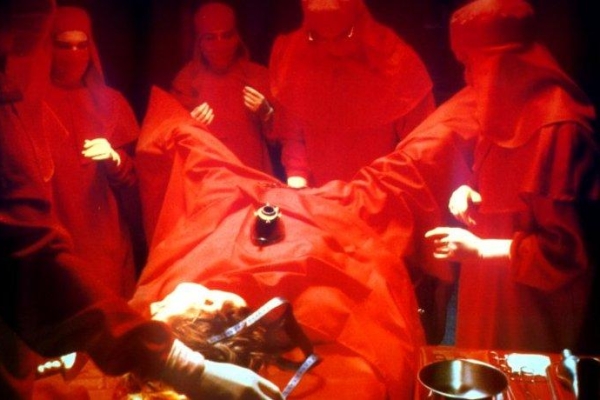
Dead Ringers
Cronenberg’s early career coincides with the publication of some significant feminist criticism on sexual difference. "A new morning of and for the world?" wrote Luce Irigaray in 1984. "A remaking of immanence and transcendence, notably through this threshold which has never been examined as such: the female sex. The threshold that gives access to the mucous...a threshold that is always half-open."
A more direct connection to Cronenberg's explorations on sexuality: the first test tube baby was born in 1978, three years after his first commercial film was released. Cronenberg commented later on this connection: "Well, I think, with Crash it was getting very focused on the idea that we are re-inventing sex. We are at a major epoch in human history, which is that we don’t need sex to recreate the race. You can have babies without sex. This is the first time in human history that has been true." In Crash, the yonic bleeding-wound symbolism takes on new significance, no longer the wound from penetration but a site of new pleasures, when a character has sexual intercourse with a gash in another character’s leg.
While Cronenberg has worked repeatedly with ideas about the awe and horrors of reproduction—most notably in The Brood and The Fly—more interesting are his explorations of a woman’s sex that have no connection to her womb, that are instead about complex pleasures, power, and fear. The most basic fact of horror is that we fear what we cannot see; Cronenberg has made a career of this vertiginous relationship to the abyss of the yonic. The most haunting scare scene in his first major movie, Shivers (or They Came From Within), which was also the poster image, is of a woman naked in a bathtub with her legs casually open and bent in the water. A slimy phallus-y horror invader crawls through the pipes of the haunted apartment building and exits through the hole of the bathtub drain, obviously heading toward the next opening. It is a terrifying reminder that there is no door to shut out entry to a woman’s body. Cronenberg’s fascination in this film is with these exposed openings to a closed system, where internal meets external. Where does the body end and the outside world begin? This fascination was taken further in eXistenZ. "How come bio-ports don’t get infected? They open right into your body," the inexperienced man played by Jude Law asks the woman—the expert—about the anus-like bio-port openings that are the site for head-fucking games for two. "Listen to what you’re saying, Pikul. Don't be ludicrous," she answers, as she opens her mouth and sticks out her tongue.
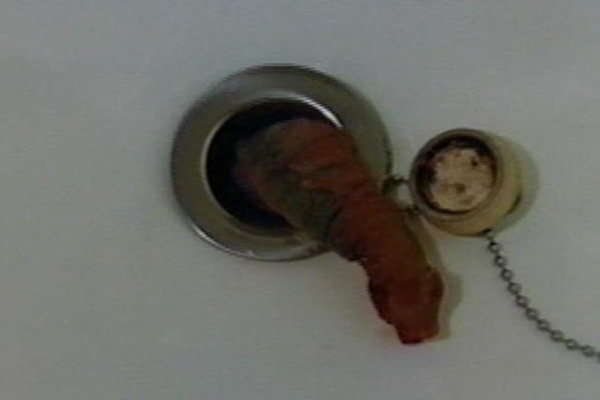
Shivers
Cronenberg followed Shivers with Rabid, which starred porn star Marilyn Chambers as an affectionate woman with an anal opening in her armpit that hides a killer clit. Not since "Little Red Riding Hood" has the clitoris found a better metaphor: a small and pointed red appendage that pops out of hiding in an embrace to stab its victims and turn them into vampiric sex zombies. The film is an awestruck examination of the insatiability of female sexuality. "Do you feel weak?" Chambers is asked by a doctor after a string of attacks. "I feel strong. I feel very strong," she says slowly with a postcoital grin. But the film also addresses her guilt once this insatiability has been awakened. "It's your fault!" she screams at her boyfriend who caused this mutation, a surprising glimpse of rage in an appropriately flat performance. "I’m crazy, I’m a monster," she says later, the woman with girl-next-door looks who locks herself in a room with a victim to prove that she’s still innocent.
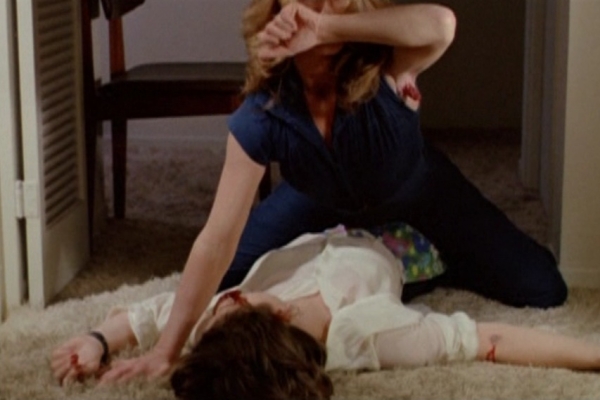
Rabid
In underestimating the clitoris, this "obviously inferior" organ that has no purpose but pleasure, Freud confused size with power, not taking into account the limitless pleasure possible in that "little penis," nor realizing that it has 4,000 nerve endings to the 2,000 nerve endings spread out over a larger space in the male anatomy. (It’s notable, too that a Freud paperback makes an appearance early in Rabid, when a woman wants to know what her father’s interest in her nose symbolizes.)
In eXistenZ, Cronenberg creates one of cinema’s only visual metaphors for the next section of a woman’s sexual anatomy, the lower region of the vagina (the knobby section that contains the woman’s G-spot and other tender buttons) turned inside out, in horseshoe-shaped game pods used as remote controls for sexually metaphoric, virtual-reality games. Made of metaflesh, the pods are pink and wrinkled and make squishy little noises of their own accord once activated. "That's ugly even for a pod," says Jude Law’s character of a diseased pod. One person can play alone with the pod, but it’s no fun, says the gaming female cult leader played by Jennifer Jason Leigh. "Then you’re just a tourist." It takes two to play. "The only way I can tell if everything is OK is to play eXistenZ with somebody friendly. Are you friendly?" Leigh asks the uptight Law. But he is resistant to having a bio-port opening (complete with "Umbi-cord") installed in his lower back.
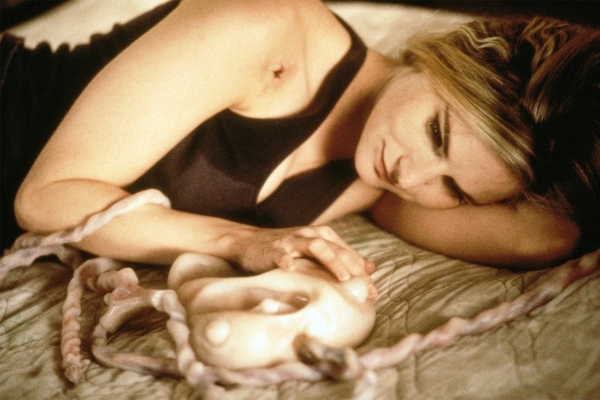
Jennifer Jason Leigh in eXistenZ
"I have a phobia of being penetrated," he says. When he does finally relent, his mind is blown: "That was beautiful. Is that kind of transition normal? That smooth interlacing from place to place?"
"It depends on the style of game," she explains. "You can get jagged, brutal cuts, slow fades, shimmering little morphs." The pod-centered game is one of the greatest depictions of female-centric (rather than hetero-phallocentric) sexuality. Yet, once again, fear follows knowledge of the power of this complex sexuality. "Death to the Demoness!" goes the rallying cry of the legions who want to kill this powerful, radical woman.
"We want you to open up," the Videodrome henchmen say to James Woods about his VCR slot/vagina stomach, as its throbbing vibration takes on a "feed me" life of its own. Perhaps Freud was not wrong but just off the mark when he said that so much of women’s behavior comes from "wanting a penis." But (pardon the heterosexual bias of this report) that is not envy; it's more like a hunger, a need to be filled. The independent life of the slot in that Videodrome scene gets at one of the most horrific and most misunderstood aspects of rape ("She enjoyed it"), because what the woman wants can have a complete disconnect, once penetration has begun, from what the gripping, pulsing vagina wants, to be filled.
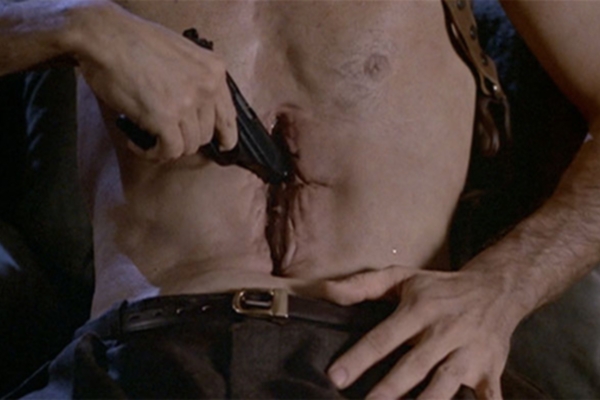
Videodrome
When it is what the woman wants, emotionally and sexually, it is less a desire to be stuffed than a shared need to be joined. "Chang and Eng were joined at the chest," Beverly, one of the twin gynecologists of Dead Ringers, says in a sing-song voice about the Siamese twins that become the twins’ own personal fable. When referring to the entire vagina, not just the "game pod" lower section—the fun part, that is, the center of a woman’s pleasure—then we’re discussing a joint, the spot where two are merged like Siamese twins. The tragic love story in this film, with a score as mournful and insidiously perverse as Vertigo’s, is about the agony of separation once those two have merged. Beverly falls in love with Claire Niveau, who not only threatens the tight union with his twin brother, but sends Bev into destructive tailspins of insecurity. When he convinces himself that she has left him, he becomes fearful about the power of this merge, bitter about the place of conjoining. "Have you examined her carefully yet?" he asks the male voice on the phone he is convinced is fucking his lover, but is actually her assistant. "Carefully lubricate the first prime two fingers of your right hand and insert them into Claire Niveau's vagina. Instead of feeling one cervical head, you will feel three." He says, finding just the right words to nauseate the gay P.A. "Basically, you have been fucking a mutant!" He then creates gruesomely primitive "instruments for operating on mutant women" for her, which at the film’s tragic conclusion become the "instruments for separating Siamese Twins."
"It is gynecology that provides the whole environment for the twins; it is an extension of their very inception," Cronenberg said at the time of the film’s release. "They form as children a complete unit, in the way a man and woman might, that excludes everyone else. Not just women. They’re utterly into themselves....The Mantle twins are mated halves of one organic unit." By the end of the film, Doctor Beverly accuses one patient of having sexual intercourse with a labrador retriever, and then hurts her on the operating table, defending himself by declaring that it was not the instruments that were at fault but her body. "The woman’s body was all wrong," he says desperately. Yet Dead Ringers is not, as some have claimed, a misogynistic film. It is in fact the greatest film about misogyny, creating a body myth about gynecology to explore how all misogyny stems from gynophobia, from fear of the power of the vagina, the site both of birth and of merge. ![]()
LATEST ARTICLES
-20140814-173707-thumb3.jpg)
Fighting Words
by Imogen Sara Smith
posted August 12, 2014

Fighting Words, Part 2
by Imogen Sara Smith
posted August 20, 2014

On the Margins: The Fil…
by Andrew Chan
posted August 12, 2014

Robin Williams: A Sense…
by David Schwartz
posted August 12, 2014
 They Came From Within
They Came From Within
RELATED ARTICLE
Laws of Desire by Tom McCormackMigrating Forms by Joshua Land
More: Article Archive
THE AUTHOR
Miriam Bale, a critic and film programmer, is the editor of Joan's Digest: A Film Quarterly. She is a regular contributor to The New York Times.
More articles by Miriam BaleAuthor's Website: Joan's Digest: A Film Quarterly

